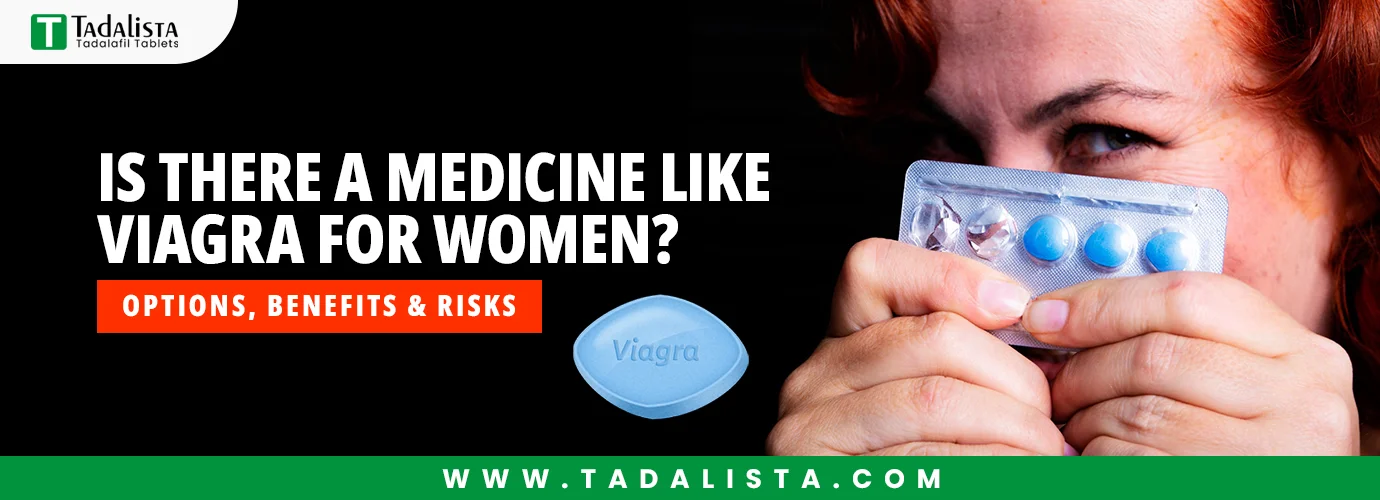Introduction
When Viagra was introduced in the late 1990s, it transformed men’s sexual health by offering an effective solution for erectile dysfunction. Known as the “little blue pill,” Viagra works by increasing blood flow to the penis, enabling stronger and longer-lasting erections. Since then, many women have wondered: Is there a medicine like Viagra for women?
The short answer is yes—but it’s more complicated than simply prescribing the same pill. Female sexual function is influenced not just by blood flow but also by hormones, emotions, and brain chemistry. This means that treatments for women look a little different from those for men. Let’s explore what options exist, how they work, and whether a true “female Viagra” is available.
Why Women May Need a “Female Viagra”
Sexual difficulties are not exclusive to men. Studies suggest that nearly 40% of women experience some form of sexual dysfunction during their lives. Common issues include:
Low sexual desire (hypoactive sexual desire disorder, HSDD)
Arousal difficulties, where physical responses such as lubrication don’t match desire
Painful intercourse, often linked to vaginal dryness or hormonal changes
Difficulty reaching orgasm
Unlike erectile dysfunction, which is primarily a circulation issue, women’s sexual health challenges are often tied to a complex mix of physical, emotional, and hormonal factors. That’s why finding a direct equivalent of Viagra for women has been challenging.
Medicines Similar to Viagra for Women
1. Addyi (Flibanserin)
FDA approval: 2015
How it works: Unlike Viagra, which acts on blood vessels, Addyi targets brain neurotransmitters linked to desire (dopamine and serotonin).
How it’s taken: Daily pill, regardless of sexual activity.
Who it’s for: Premenopausal women with low sexual desire not caused by medical or relationship issues.
Limitations:
Does not work immediately before sex.
Cannot be combined with alcohol (risk of severe low blood pressure).
Side effects: dizziness, sleepiness, nausea.
Addyi is often called the first “female Viagra,” though it works on brain chemistry, not blood flow.
2. Vyleesi (Bremelanotide)
FDA approval: 2019
How it works: A self-injectable drug that activates receptors in the brain involved in sexual desire.
How it’s taken: Injection under the skin about 45 minutes before sexual activity.
Who it’s for: Premenopausal women with generalized HSDD.
Limitations:
Not for daily use.
Can cause nausea, flushing, injection-site pain.
Only effective for some women.
Vyleesi is often compared to Viagra because of its on-demand use before sex, though it still works through brain signaling, not genital blood flow.
3. Sildenafil (Viagra) for Women
FDA approval: None (for women).
Research: Some studies show Viagra can increase genital blood flow in women, potentially improving arousal and lubrication.
Limitations:
Mixed clinical trial results.
Most effective in specific cases (e.g., women with antidepressant-related sexual dysfunction or postmenopausal women).
Not officially approved for female sexual dysfunction.
While Viagra may help some women physically, it does not consistently improve sexual desire or satisfaction.
4. Hormone Therapy
Estrogen therapy: Treats vaginal dryness and discomfort, often linked to menopause.
Testosterone therapy: In some cases, low-dose testosterone may help improve sexual desire in women.
Limitations: Requires medical supervision, as hormones can affect overall health.
Hormone treatments are not “female Viagra,” but they can be powerful tools for restoring sexual comfort and interest, particularly in postmenopausal women.
How Female Treatments Differ from Viagra
Viagra for men works in a straightforward way: it relaxes blood vessels and increases circulation to the penis. Female sexual function, however, is influenced by:
Blood flow to the genital area
Hormones (estrogen, progesterone, testosterone)
Brain chemistry (dopamine, serotonin)
Psychological factors (stress, mood, relationship quality)
That’s why no single pill works for all women. Treatments like Addyi and Vyleesi target brain chemistry, while hormone therapy focuses on biology, and Viagra may only affect circulation.
Potential Benefits for Women
Depending on the treatment chosen, benefits may include:
Increased sexual desire
Enhanced arousal and lubrication
Reduced discomfort during intercourse
Improved sexual satisfaction
Boosted self-confidence and relationship intimacy
It’s important to note that results vary—what works for one woman may not work for another.
Risks and Side Effects
Addyi
Sleepiness, dizziness, nausea
Dangerous interactions with alcohol
Must be taken daily, not on-demand
Vyleesi
Nausea and flushing
Injection-site pain
Possible increases in blood pressure
Viagra (off-label for women)
Headache, flushing, nasal congestion
Low blood pressure when combined with alcohol or nitrates
Limited proven benefit for women
Hormone Therapy
Breast tenderness, bloating, mood changes
Long-term risks (depending on dose and duration)
Because of these risks, women should only consider these medications under medical supervision.
Non-Medication Alternatives
Not all sexual health challenges require a pill or injection. Many women benefit from:
Counseling or sex therapy: Addresses psychological and relationship factors.
Lifestyle changes: Exercise, stress management, and better sleep can enhance libido.
Lubricants and vaginal moisturizers: Improve comfort and arousal during sex.
Mindfulness or relaxation techniques: Reduce performance anxiety and increase connection.
Conclusion
So, is there a medicine like Viagra for women? Yes—but not in the same way Viagra works for men.
Women have several options, including Addyi, Vyleesi, hormone therapy, and in some cases sildenafil (Viagra off-label). These treatments address different aspects of sexual function, from brain chemistry to hormones and blood flow.
However, no single medication is a one-size-fits-all solution. Female sexual health is more complex, involving both the body and mind. That’s why the most effective approach often combines medical treatment with lifestyle changes, therapy, and open communication with a partner.
If you’re considering treatment, consult with a healthcare provider to find the safest and most effective option for your unique needs.
As a pharmaceutical researcher and medical writer with over 10 years of experience, I focus on erectile dysfunction treatments—from clinical insights to real-world use. I’m passionate about improving men’s health through safe, effective, and research-backed solutions.


